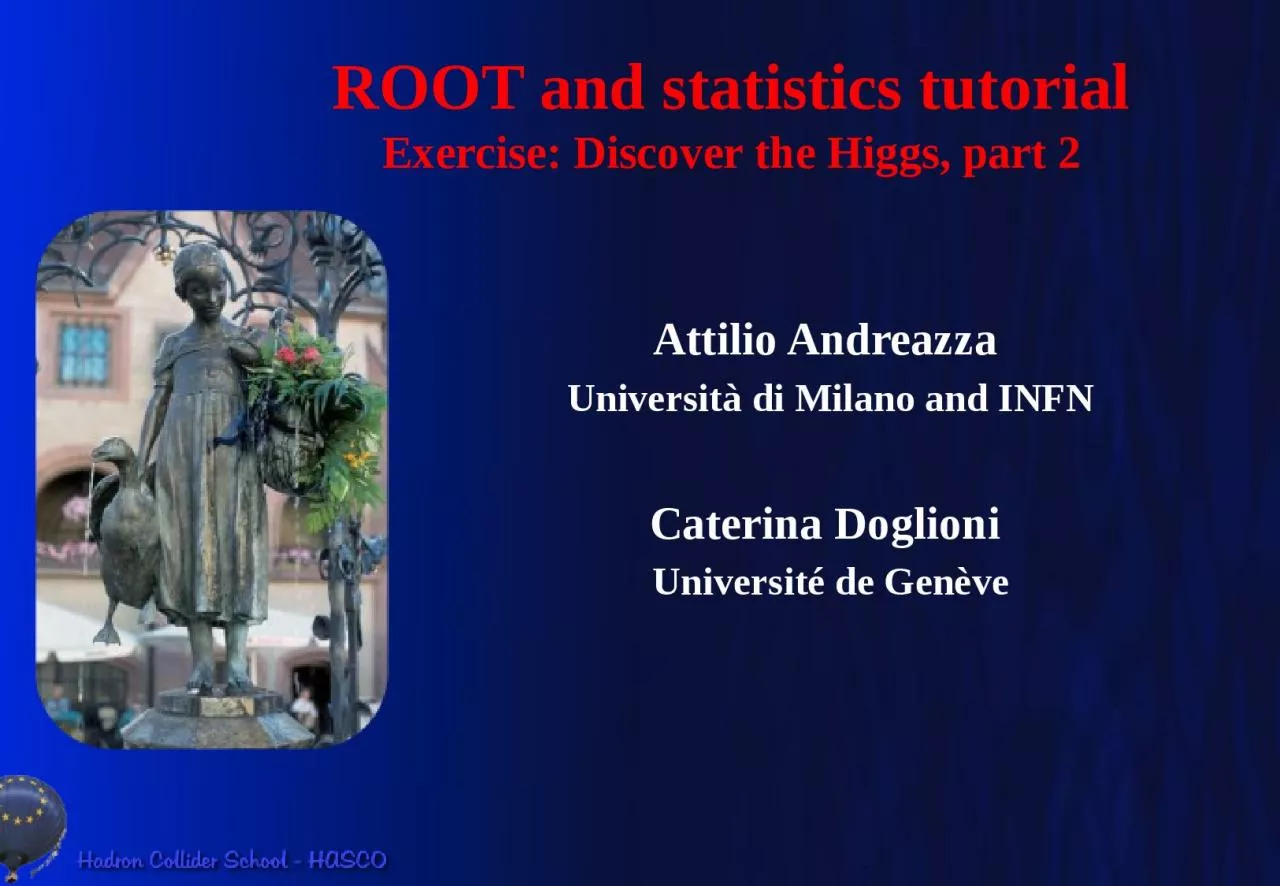

Exercise Discover the Higgs part 2 Attilio Andreazza Università di Milano and INFN Caterina Doglioni Université de Genève Outline What will we do today Discover ID: 1002567
Download Presentation The PPT/PDF document "ROOT and statistics tutorial" is the property of its rightful owner. Permission is granted to download and print the materials on this web site for personal, non-commercial use only, and to display it on your personal computer provided you do not modify the materials and that you retain all copyright notices contained in the materials. By downloading content from our website, you accept the terms of this agreement.
1. ROOT and statistics tutorialExercise: Discover the Higgs, part 2Attilio Andreazza Università di Milano and INFNCaterina Doglioni Université de Genève
2. OutlineWhat will we do today:Discover the Higgs boson of course! ...well, check ATLAS is not cheating us What we will learn!Computing confidence levels based on Poissonian statistics.Compute confidence levels based if the expected m(B,S) is uncertain.For people running fast:Expected 95% level exclusion + error barsRoot and statistics tutorial: Exercises22011+2012 dataDataset 2011 2012 2011+2012Expected B only 2±0.3 3±0.4 5.1±0.8 Expected S mH=125 GeV 2±0.3 3±0.5 5.3±0.8 Observed in the data 4 9 13In the region 125 ± 5 GeVFrom F. Gianotti’s Higgs seminar
3. Confidence level definitionDefinition of confidence levelN.B.: this is the frequentist definition, not the Bayesian one from the lectures, but that allows you to make all computations by yourself and to grasp the main features of the problem.A certain criterion rejects an hypothesis with C.L. a if, in case the hypothesis is true, it would be erroneously rejected by that criterion on a fraction 1-a of the cases. In our exercise:We observe a certain number of eventsNobsWe expect a certain number of background events:NBDiscovery: we reject the hypothesis our sample contains only background events if:Exclusion: we reject an hypothesis expecting NS signal events if:Root and statistics tutorial: Exercises3
4. Confidence level computationAt first just assume a Poisson statistics:We can compute the probability summing the probabilities of all N up to Nobs But we want to use a Monte Carlo method!Why? It will be easier to extend to the treatment of systematic uncertainties (this is what BAT or RooStats do for example).What to do:Sample the probability distribution M times (say M=10000)Count how many cases M’ the value of N exceeds (or is lower than, if appopriated) Nobs. We can reject the hypothesis if M’/M<1-a.Something like: Int_t M=0; for (Int_t i=0; i<10000; i++) { Int_t N = gen.Poisson(NB); if ( N>=Nobs ) M++; } Double_t CL = 1.-M/10000.Root and statistics tutorial: Exercises4
5. Computing confidence levelsNeglecting uncertainties on NBWith which CL can we reject the background-only hypothesis when using:Only 2011 dataOnly 2012 dataThe combined setIf one would have been observed only the expected backgroun (i.e. Nobs =2,3 and 5 events respectively for 2011, 2012 and combined dataset), with which confidence level one would have rejected the hypothesis of the Higgs presence?Repeat adding the uncertainty on the m value of the Poisson distribution. Assume the uncertainties on NB and NS are fully correlated.In such a situation and the integral can be performed by sampling NB from a Gaussian distribution and afterward sampling N.Root and statistics tutorial: Exercises5
6. Computing exclusion limitObserved exclusion limit: after getting Nobs events, all NS>N0,S are excluded at confidence level a, where is the N0,S minimum one satisfying the relation: Determining this minimum, even in this simple case is quite computationally expensive, and special tools are usually employed. Expected exclusion limit:Is the one that would obtained if Nobs would correspond to the median ofThe ±1s expected values correspond to the limit that would be obtained if Nobs would coincide with the 16% and 84% percentiles of The ±1s expected values correspond to the limit that would be obtained if Nobs would coincide with the 2.25% and 97.75% percentiles of Compute the expected limits for ATLAS and mH=125 GeVRoot and statistics tutorial: Exercises6
7. 72011 data2012 data2011+2012 dataExcluded (95% CL): 130-170 GeV Expected: xxxx GeVExcluded (95% CL): 131-162, 170-460 GeV Expected: 124-164, 176-500 GeVRepeating the same calculation for all mH hypothesis is the way the famous band plots are produced.From F. Gianotti’s Higgs seminar